Books like this make me happy, they excite me, make we want to dash out and learn more more more and create… I told my friends that if I hadn’t already bought them presents for Christmas, I would have bought each of them a copy of this book. Kate looked at my copy, and promptly took all the info to order it for her town Library (her town is SO lucky to have her as their Librarian, but I digress…)… What book? Personal Geographies: Explorations in Mixed Media Mapmaking by Jill K. Berry.
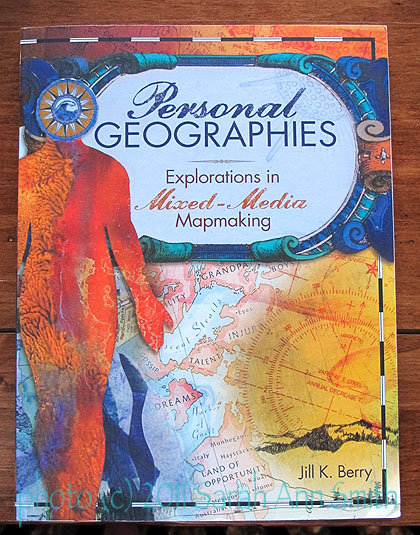
Personal Geographies by Jill K. Berry.
Order from her here or Amazon.com here.
Ya know how a comment from an internet friend, especially one in a small group where you get to really know each other and know a suggestion is worth checking out, will set you off to check out a link for a tutorial, which will lead you a person’s blog, then their website, and on and on? And then you find out she has just published a book…on a subject you adore? In this case, it was this tutorial on geo-papers and Jill Berry’s blog and book about maps…all SORTS of maps!
True confessions: I will admit to being totally, utterly biased. I LOVE maps and I LOVE color and I really enjoy a bit of whimsy. But let’s start at the beginning:
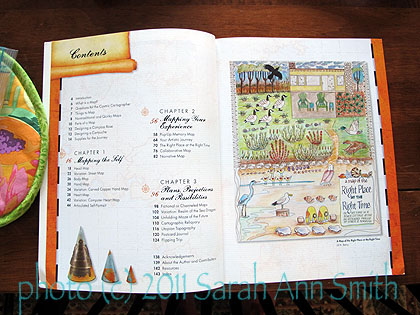
Table of Contents
As you can see from the map on the right page, it’s not all about continents and streets and the bird’s eye view from the height of an orbiting satellite… that map is about the Right Place at the Right Time…oooh what a cool concept to turn into a map! You know straight off you’re not in for some dry tome on elevations and political boundaries, at least in the usual map-sense. This book begins with some basics:
- What is a Map
- Questions for the Cosmic Cartographer
- Things to Map
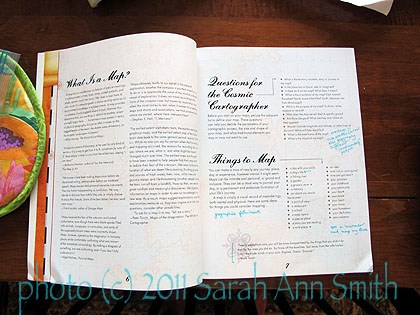
"What is a Map" from Personal Geographies; as you can see, I was so excited reading it and full of ideas I had to write them down in aqua ink right there on the page--any book that does that to me is a GOOD BOOK in my world!
- Nontraditional and Quirky Maps
- Parts of a Map
- Designing a Compass Rose
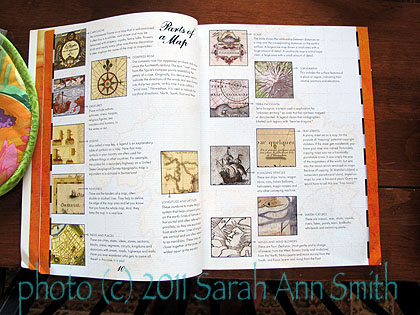
Parts of a Map---pages like this make me want to learn more, see more old maps....
- Designing a Cartouche
- Supplies for the Journey
Now…I am a book fiend AND I love to delve MORE into the information… I was thrilled that in the back is a Resource section that coers not only where to get STUFF, but where to get more information…like research sites and good books for learning more. Guess where I’m going …the internet and inter-library loan!!! and I may be adding a couple of new reference books to my groaning book shelves! I mean…how tempting is it to know there is a site where you can learn the history of sea monsters?!!!! OK… I’m really not gonna go surf now…really…..
Then there are the three major sections of the book:
- Mapping the Self
- Mapping Your Experience
- Plans, Projections and Possibilities
Oh me Oh MY…..just re-reading this makes me want to stop writing and go PLAY and DO! But I will restrain myself just a bit… just for you dear readers!
One of the first maps is this one which, when you read the words closely on the top layer (“My Idea of My Neighbors’ Day not mine”) and suss out the words on the underneath layer (Jill’s life) are just hilarious…makes me wish Jill were my neighbor–this is someone with whom you can have fun! I’ll just have to do that via her book.
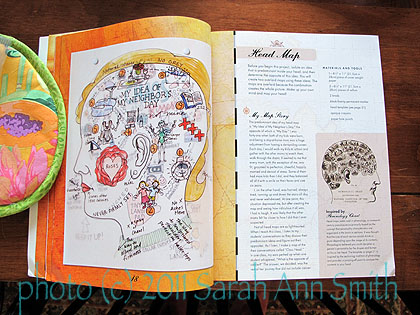
Jill K. Berry's"Head Map"--please remember all these pages and artwork are Jill's and respect her copyright!
Just one example…on the nape of the neck it reads on the top layer: The way to sculptured shoulders perfect in halter tops. On the underneath layers: several blog shapes with the notation: spit-up land. What a hoot… anyone who has been a mom or babysat remembers having shoulders like that!
Another cool thing Jill did is to ask a dozen mixed media art buddies (including Jane LaFazio, whose classes I’ve taken online….) to try making a map–something they had never done before. She sent them the projects in this book, and they each tried… and wow what they did… it is so much FUN!
As usual for me, I wish there were more more more of the information up front, and not quite so many projects, but that is just me. The set up of the book is pretty standard for what you see in the quilty world, too: information up front, projects in back, a smattering of art from other artists to illustrate the author’s writing, and resources, index, biographies of contributors, etc. in the back. That’s just a quibble…I’m greedy: I WANT MORE! So thanks to this book, I’ll set off on my own map journey, which will include going to that sea monster site. Now! And oh yeah, in case you hadn’t figured it out, I can highly recommend this book, especially if you like maps, or if you just want a lark into a mixed media thingy that might just open whole new ideas for you!





